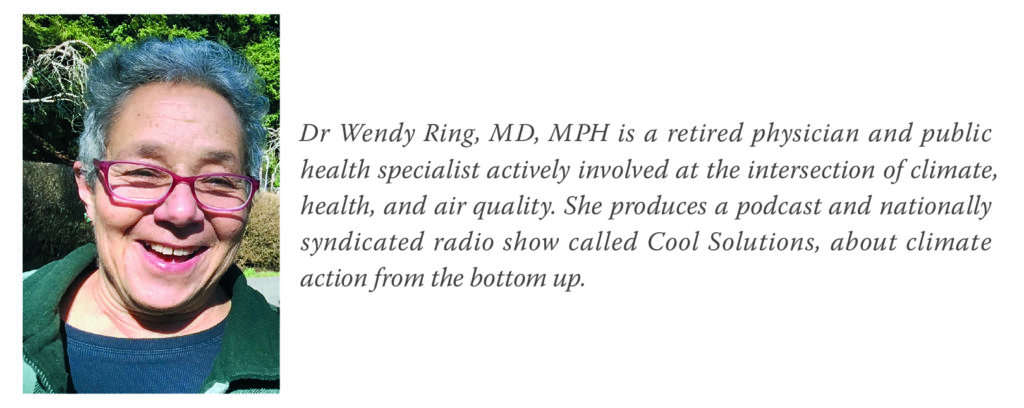The Best Use of Biomass Isn’t Burning
By Wendy Ring
While the COVID pandemic and the accompanying drop in greenhouse gas emissions had us temporarily focused on other problems, recent bouts of extreme weather are reminders that climate change has not gone away. Global carbon emissions are rebounding, with December 2020 levels exceeding those from December 2019, while decreased tax revenues from the economic crisis have state and local governments scaling back ambitions for climate action. Climate impacts that increase emissions, like permafrost melting and boreal forest fires, are more extensive than predicted; and scientists agree it is extremely likely that global warming will exceed 1.5C by 2030. We can either go fatalistic and abandon ourselves to hedonism and me-first survivalism, or mobilize and pull ourselves back from the precipice.
For California to reach its goal of carbon neutrality by 2045, experts agree that in addition to steeply dropping carbon emissions, we must remove carbon from the atmosphere. Whereas direct air capture of carbon dioxide costs $200 per ton, and gasification or pyrolysis of biomass with carbon capture and storage costs $50–100 per ton, applying compost to crop and range land accomplishes the same thing for a mere $10 per ton. This is not to imply that compost alone can save the world, but the faster we reduce emissions, the less carbon we’ll need to remove, and in the case of biomass, compost does both.
Let’s look at what this could mean for Humboldt County. Humboldt’s largest source of greenhouse gas emissions is transportation, but in a large rural county with 1 in 5 residents below poverty level, we don’t have great prospects to rapidly electrify our vehicles or get people out of their cars. We have a biomass plant that emits twice as much carbon per kilowatt hour as coal. Shutting it down would cut greenhouse gas emissions as much as eliminating half the cars in the county. If we compost our mill waste instead of burning it and apply the compost to our 700,000 acres of agricultural land, we’re not just getting rid of unwanted material. Compost stimulates plant growth and photosynthesis that removes carbon dioxide from the air. In the near term, it’s probably the biggest and cheapest thing Humboldt County can do for the planet.
Composting mill waste instead of burning it has a number of local benefits. Agricultural land treated with compost is more productive and resistant to drought and erosion. State incentives for compost application mean more income for farmers and ranchers. Biomass plants are a major source of fine particulates, which the EPA allows them to emit in large amounts because the technology is inherently dirty. These tiny particles are a well-established cause of heart and lung disease, cancer, diabetes, increased hospitalizations, and premature death. Ending biomass combustion means cleaner air and healthier communities.
Just as there are cleaner and less climate-damaging alternatives for mill waste, in Humboldt we have cleaner and less climate-damaging sources of electricity than biomass. While we need to get off fossil fuel, the natural gas plant that supplies most of our electricity could temporarily take up the slack. Substituting natural gas for biomass would cut carbon emissions per kilowatt hour by 70%, and the lower cost would free up funds to speed the development of local clean energy.
The biggest barriers to climate action are the belief that if we do nothing, things will remain the same, and the tendency of our elected officials to kick the climate can down the road rather than upset powerful interests. Despite substantial local opposition to biomass, Humboldt’s Redwood Coast Energy Authority is currently negotiating a new 10-year contract that would cost our county its biggest opportunity to lower greenhouse gas emissions. Ten more years of biomass is something we’ll deeply regret in years to come.
On a brighter note, SB 1383 is giving California a big push toward composting. Next year all but the very smallest California jurisdictions must begin collecting organic waste separately from garbage. Zero Waste Humboldt is working on a baby step—a pilot project composting a combination of food and mill waste on a local farm. Small farms do this in other states, but California doesn’t allow it unless the farm maintains an expensive permit as an industrial compost facility. We hope our research pilot will prove the safety of on-farm composting and lead to a change in the rules, while raising local awareness of compost as a negative-carbon solution.

